Have you heard of the Basilica Minore del Santo Niño de Cebu? This beautiful and majestic structure is a symbol of faith, history, and culture in the Philippines. Located on Magallanes Street in Cebu City, this old Roman Catholic church is known for its religious significance but also attracts many local and international tourists who are interested in learning more about its grand architecture and rich heritage.
Also Read: Getting a Foot Reflex in Sto. Niño Church Cebu
At nearly 500 years old, there’s no denying that the Basilica Minore del Santo Niño de Cebu has quite a past. In this blog post we’ll explore all aspects of this stunning destination – from its fascinating backstory to what makes it such an important site today.
Nestled in Cebu City, Philippines stands the illustrious Santo Niño Basilica – a Roman Catholic church constructed over four and a half centuries ago. This sacred place of worship was founded by Fray Andrés de Urdaneta and Fray Diego de Herrera in 1565, claiming to be built on the same spot where Miguel López de Legazpi found an image of the Santo Niño during his expedition. As one of oldest churches standing today, it is still revered for its spiritual significance throughout the country.
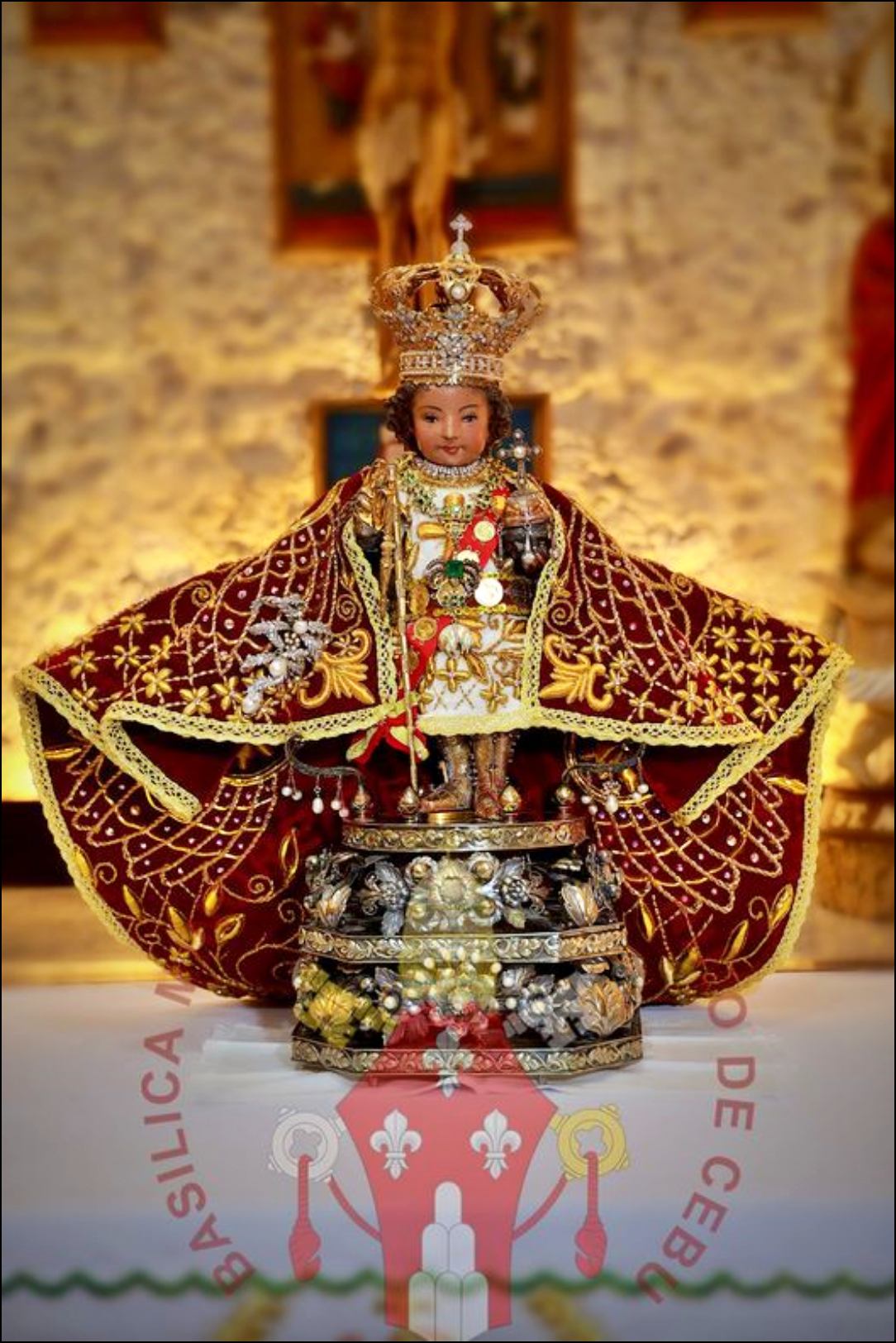
On April 14, 1521, Ferdinand Magellan presented a statue of the Child Jesus to Rajah Humabon’s consort at their baptism into Roman Catholicism. Forty years later, Juan de Camuz discovered the image in a wooden box after Legazpi destroyed an adjacent village. When Pope Paul VI inducted it as a basilica in 1965, he declared that it was “The representation and evolution of Christianity’s presence in the Philippines.” Constructed between 1739 and 1740, this impressive building was honored by the Holy See as a “Mother and Head of all Churches in the Philippines”.
History
On April 28, 1565, Fray Andrés de Urdaneta established the Church of the Holy Child after discovering an image of the Holy Child in a partially destroyed hut. After more than one week passed and the rediscovery was made on May 8th by Miguel Lopez de Legazpi, he initiated building what is now known as the first Spanish settlement in all of Philippines. On the exact spot where a figure of the Santo Niño was unearthed, they built an abbey dedicated to the Holy Name of Jesus.
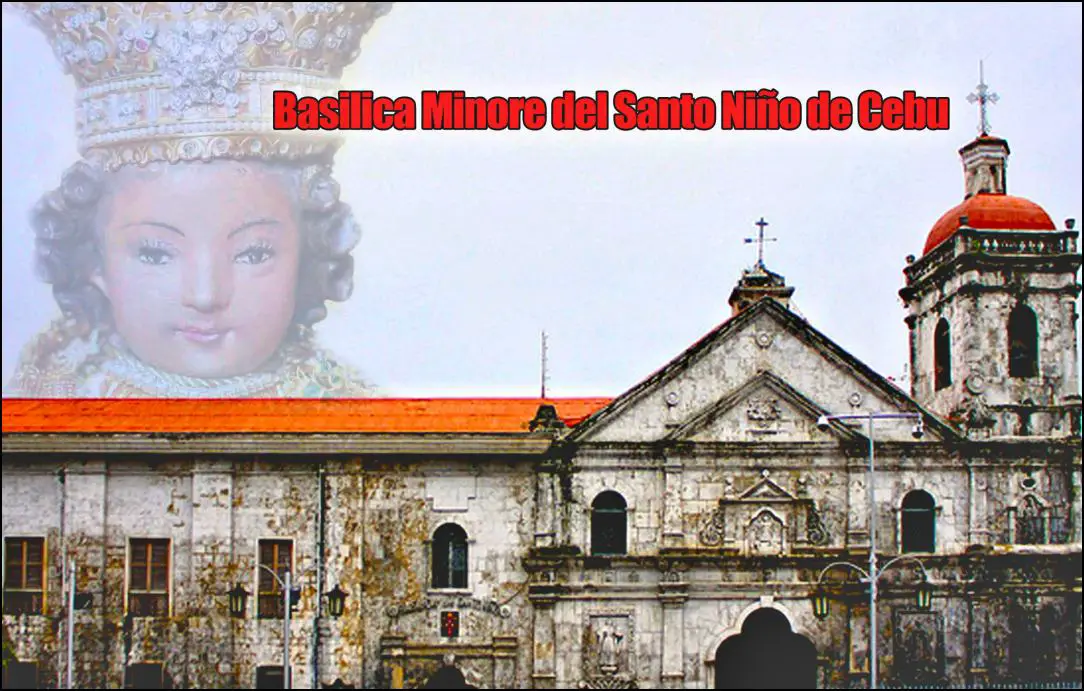
On November 1, 1566, the first church to inhabit the site where a representation of the Holy Child was found tragically burned down. Fr. Diego de Herrera had constructed it with wood and nipa prior to its destruction.
In 1605, Fray Pedro Torres, O.S.A began the initial steps towards constructing a new church in the area that was eventually completed twenty-one years later in 1626; however, it suffered misfortune and burned down just two months afterwards. Consequently, Fray Juan Medina, O.S.A took charge of reconstructing a more sustainable structure out of stone and brick–a tremendous feat for such an era. Nevertheless, building works were halted due to some structural defects that had been detected during construction process inspections.
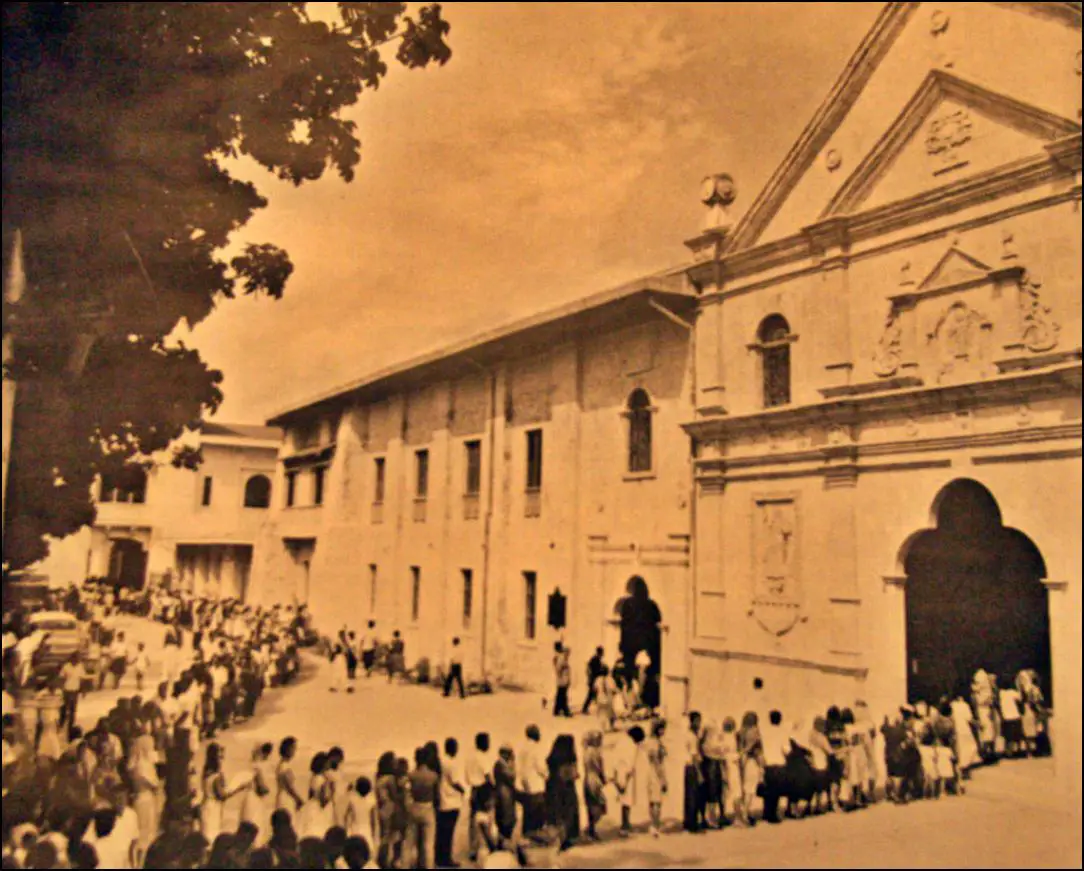
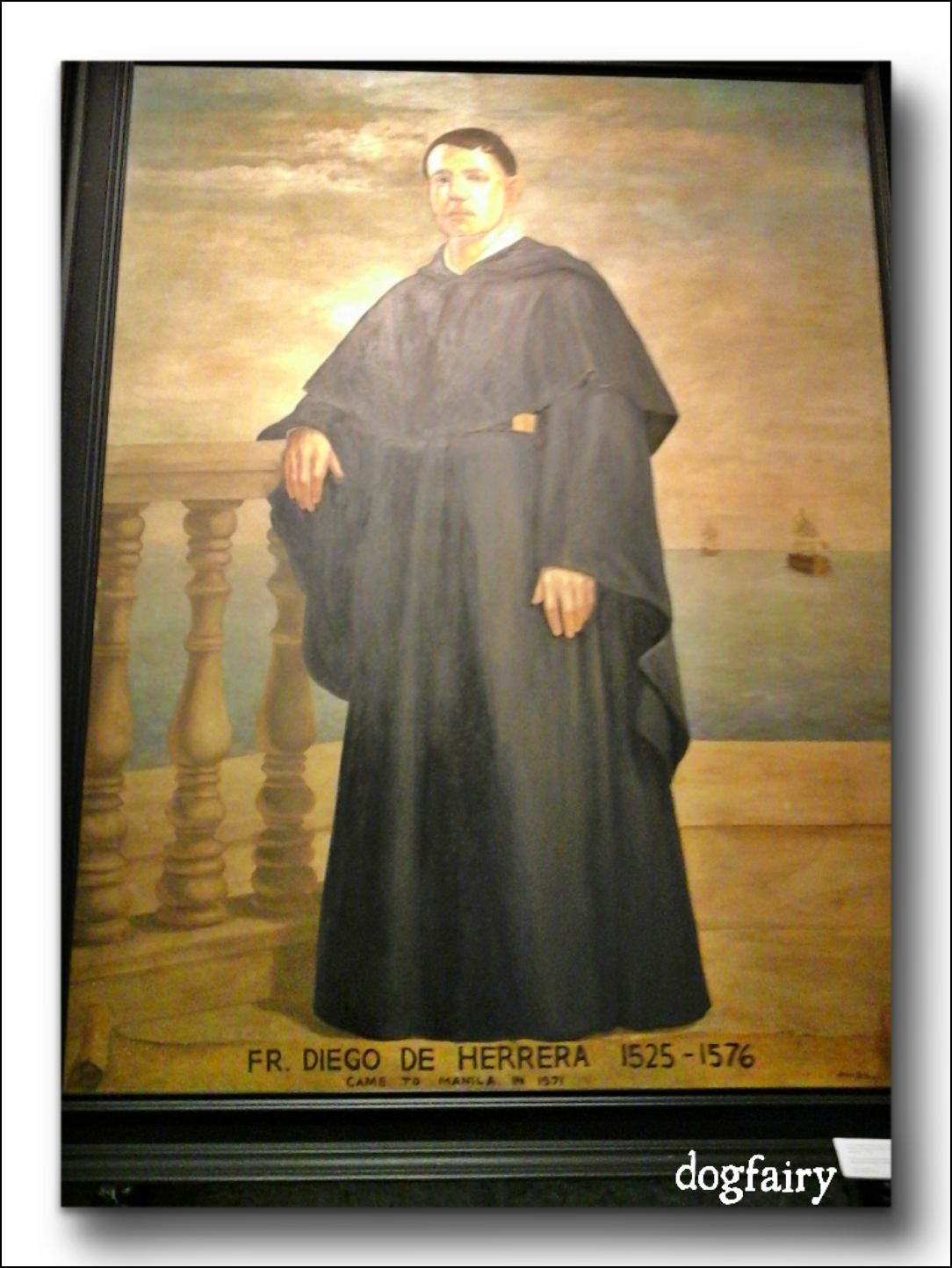
Pilgrim Center
With its ever-growing number of devotees, the Basilica soon found it difficult to accommodate them all. In response, a Pilgrim Center was built nearby and opened in September 1990 — an open-air structure capable of seating 3,500 people who can gather for mass on Fridays or celebrate religious festivities here. And don’t forget that beneath this center lies the Basilica Del Sto Niño Museum.
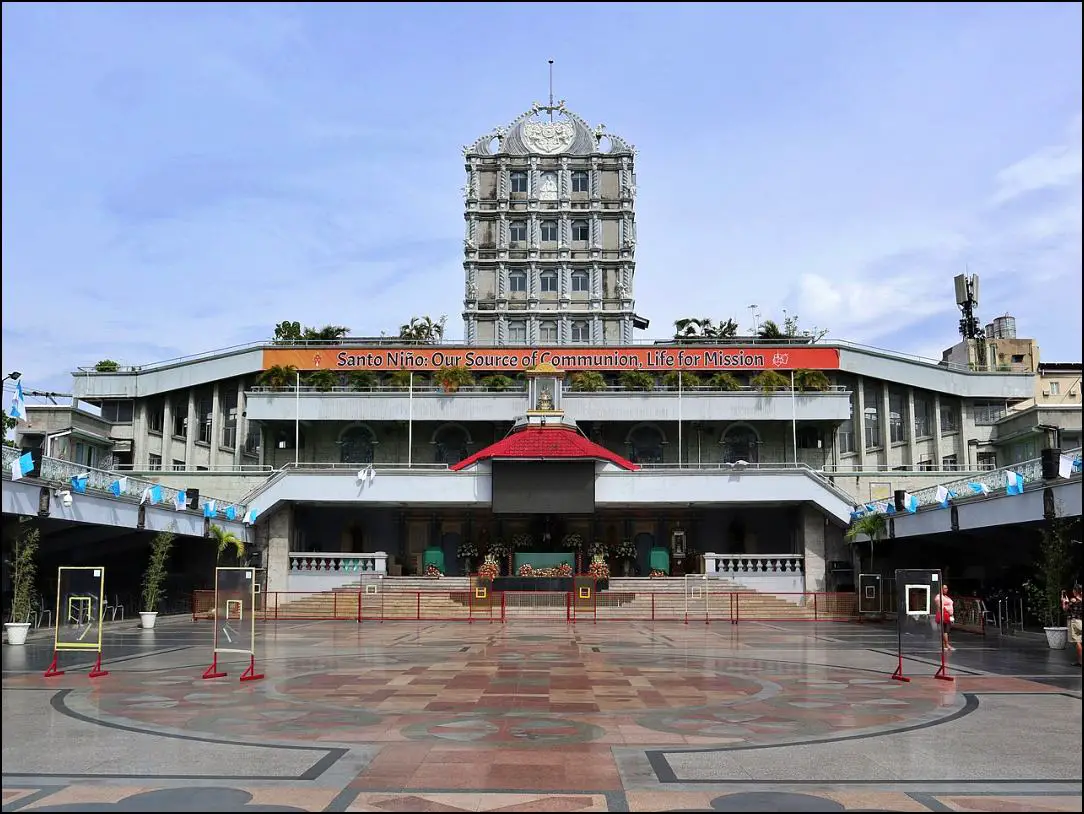
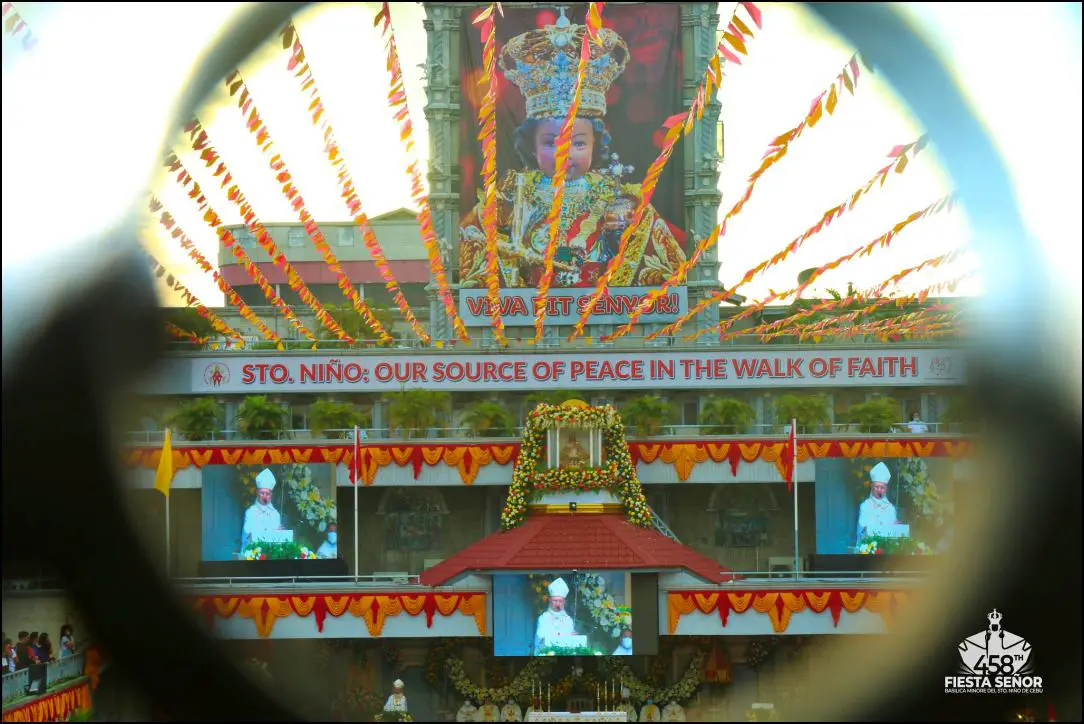
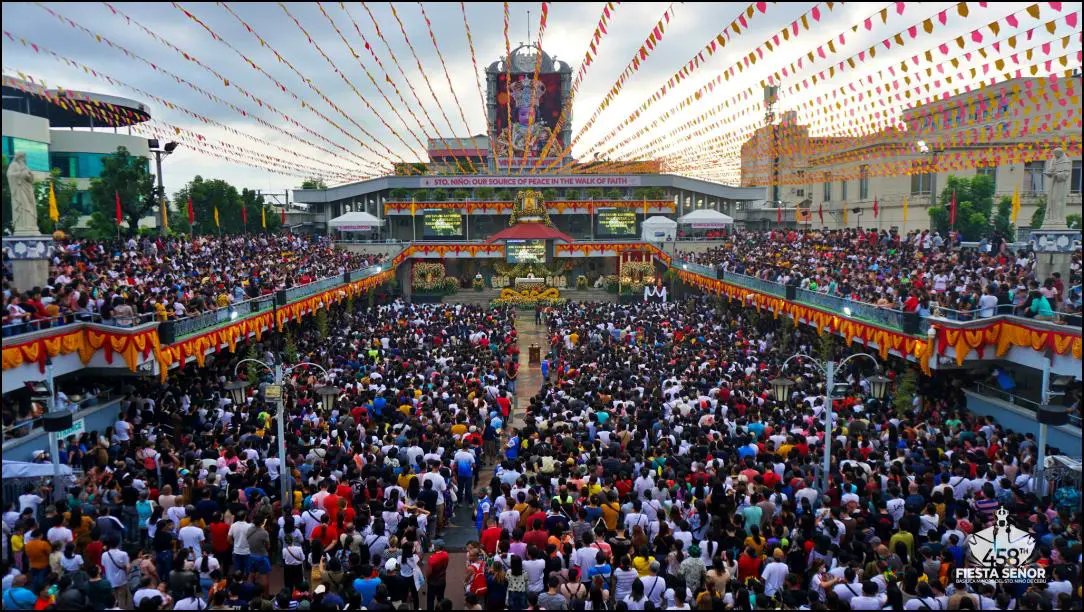

Museum
Back in 1965, Fr. Ambrosio Galindez, O.S.A., founded the museum to honor the 400th anniversary of Catholicism’s introduction to The Philippines and located it within a single room of its convent walls. Visitors can admire ancient documents spanning centuries as well as antique church furniture, ceremonial objects such as Chalices and Altar Tables, plus priestly garments from yesteryear on display.
The Sto. Niño de Cebu’s historic vestments, dating back centuries to the 17th century, are on exhibit for all to see. Alongside this, relics and statues of various saints grace the showroom while replicas of the Sto Niño used in pilgrimages throughout Philippines and beyond can be found as well. Donated jewelry pieces and toys gifted in devotion to the divine figure also have a place among these hallowed artifacts. Nestled in the Pilgrim Center’s basement, is the grand Basilica del Sto. Niño Museum – a must-see.

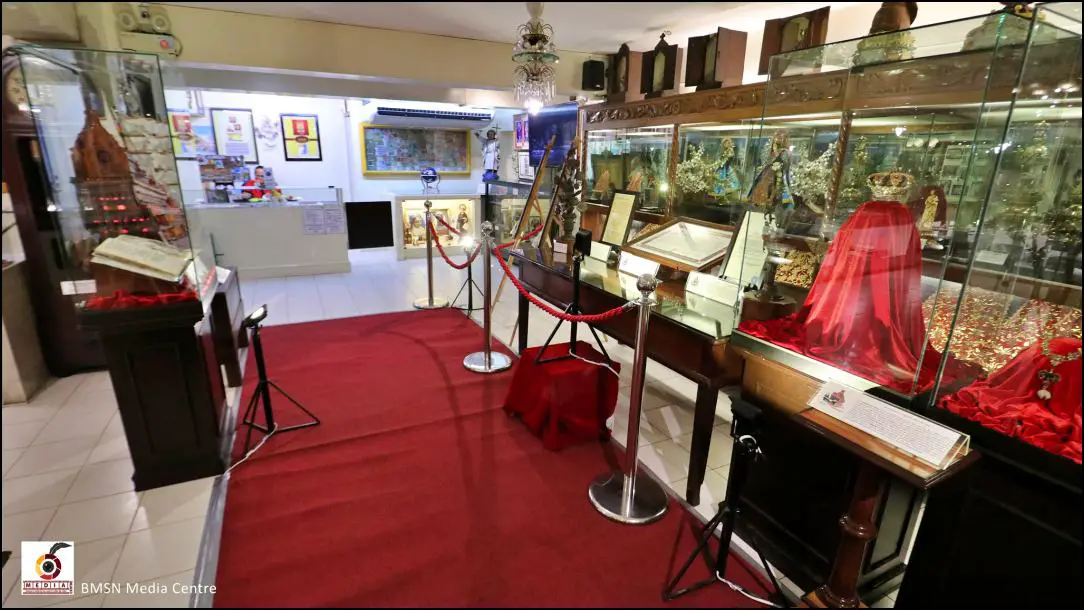
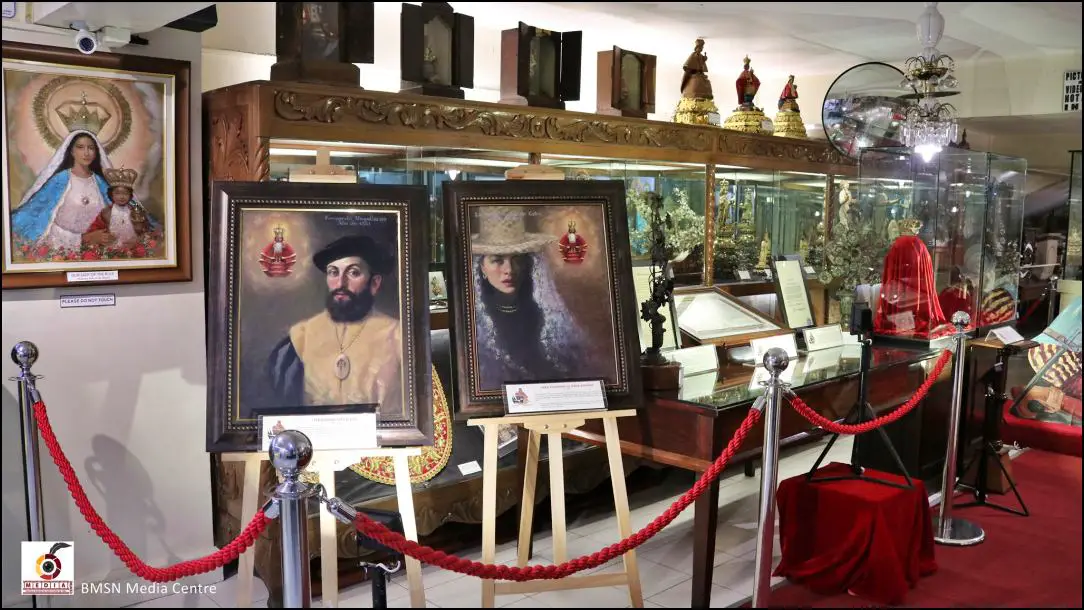
Basilica del Santo Niño Library
In 2000, the church library which was once accessible to only friars, opened its doors to all nonclerical researchers. The expansive collection includes religious subjects as well as history, science, philosophy and Filipiniana material. Additionally, it offers periodicals for those who are serious about digging deep into their research.

Why are Filipinos devoted to Sto. Niño?
Filipino devotees are especially captivated by the holy childhood of Jesus Christ, Son of God and born to the Virgin Mary through the Spirit who dwelled among us. Understanding this about St. Nino brings a deeper level of appreciation for their commitment to him, given his lovable face which tugs at people’s hearts like no other.
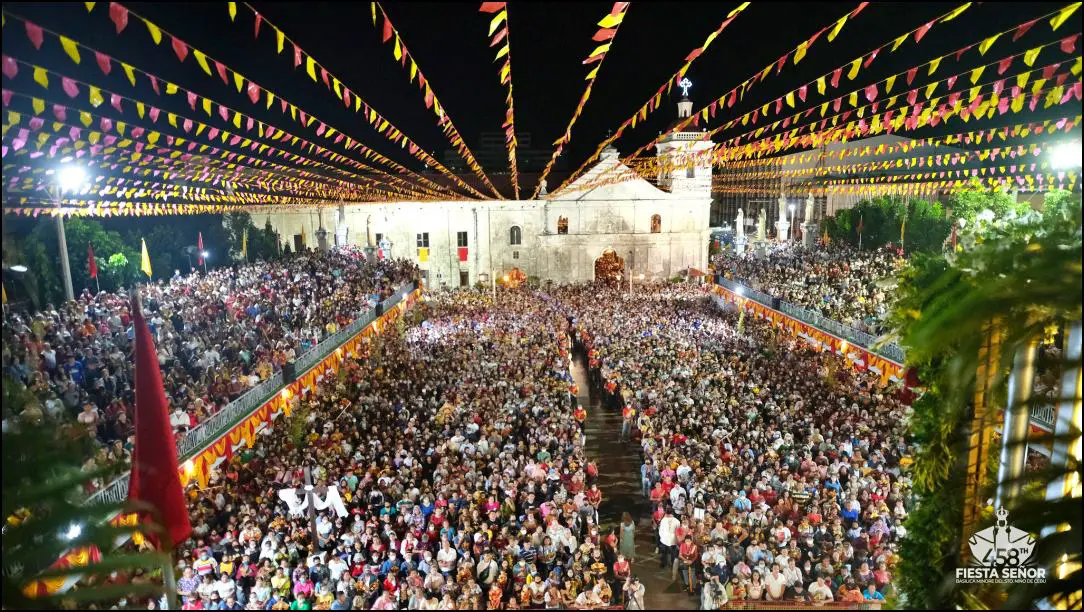
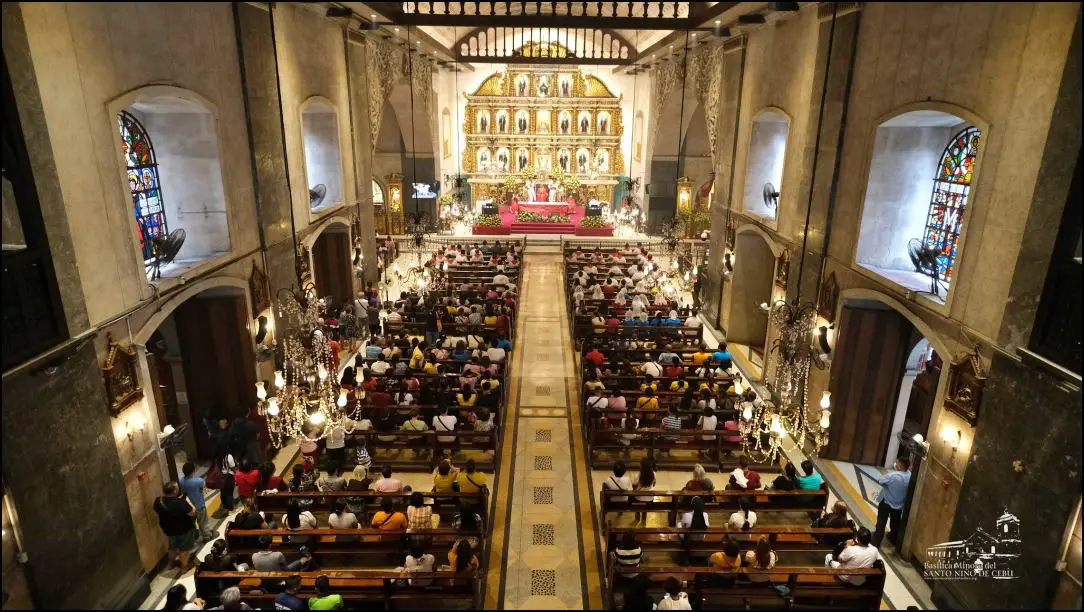
What is Santo Niño celebration?
The Santo Niño celebration is an annual event held in the Historic Basilica Minore del Santo Niño de Cebu. It is a religious event that takes place on every third Sunday of January each year, to commemorate the Christianization of Cebu by Ferdinand Magellan and his crew in 1521. The main highlight of the celebration is the procession of the Santo Niño de Cebu, a priceless religious artifact that was gifted to Queen Juana and Rajah Humabon by Magellan during his voyage.
Also Read: Exploring the Historic Magellan’s Cross in Cebu
During the event, devotees carry images of the Santo Niño around town in elaborate processions and offer special prayers for blessings. The celebration is capped off with a mass, followed by the novenas and other religious activities. It is a vibrant display of faith and devotion to the Santo Niño that has became a symbol of Cebu’s rich history and culture.
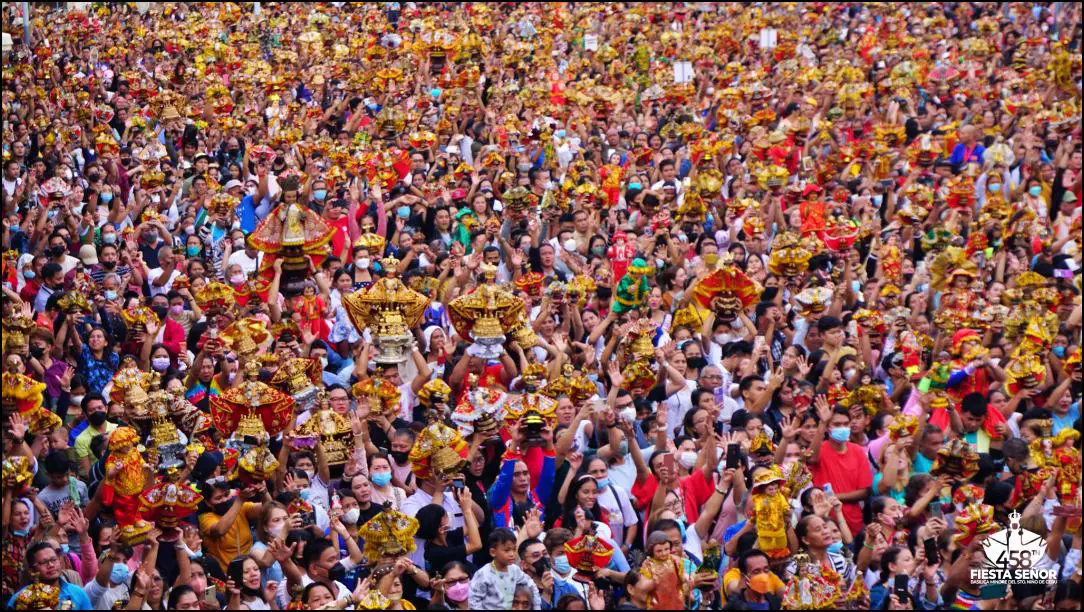
SCHEDULE OF MASSES
Please refer to the schedule of masses at the Basilica to plan your visit. Masses are celebrated in Cebuano and English, so visitors can be sure to understand the spiritual celebration of their faith.
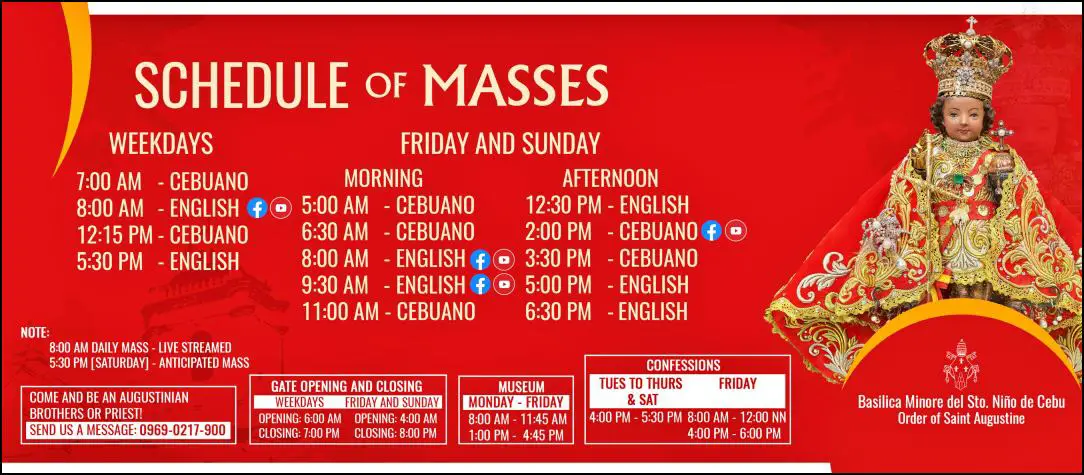
Attractions Near Basilica Minore del Santo Niño de Cebu
Here are the attractions near Basilica Minore del Santo Niño de Cebu that are worth a visit:
-
Magellan’s Cross
-
Fort San Pedro
-
Heritage of Cebu Monument
-
Cebu Metropolitan Cathedral
-
Casa Gorordo Museum
-
Yap-San Diego Ancestral House
-
Cebu Provincial Museum
-
Plaza Independencia
-
Taboan Public Market
-
Carbon Market
-
Jesuit House Museum
-
Cebu Taoist Temple
-
Archdiocesan Museum of Cebu
How to Get from SM Cebu to Basilica Minore del Santo Niño de Cebu
Bus – The most convenient way to get from SM Cebu to the Basilica Minore del Santo Niño de Cebu is by taking a bus. You can take a bus from the main SM City Cebu terminal located near the entrance of the mall and board it going towards Osmeña Boulevard. From there, you can get off at the Basilica stop, located across from Fort San Pedro. Estimated fare is ₱25 – ₱40.
Taxi – Another option is to take a taxi from SM City Cebu. This may be more expensive than taking the bus but will get you to your destination faster and with less hassle. Tell the driver you are going to Basilica Minore del Santo Niño de Cebu and they should know the way. Estimated fare is ₱100 – ₱150.
Grab – You can use Grab which should cost you about ₱150 – ₱200 and take about 15 minutes depending on the traffic.
Angkas – You can use Angkas which will cost you around ₱100 – ₱150 and take 10 minutes depending on the traffic.
Frequently Asked Questions
1. Are there any special events or celebrations held at the Basilica del Santo Niño?
A: Yes, the Basilica Minore Santo Niño de Ceb holds several religious festivals throughout the year, including the Sinulog Festival and Fiesta Señor (The Feast Lord). The most important celebration is the Feast of the Santo Niño which takes place on 3rd sunday of January every year, and draws millions of pilgrims from all over the world. During this celebration, there are processions, concerts, and other special events held in honor of the Santo Niño de Cebu.
2. What special precautions should I take when visiting the basilica?
A. As with any crowded public place, it is important to stay alert and aware of your surroundings when visiting the Basilica Minore del Santo Niño de Cebu. Be sure to adhere to the dress code when entering religious sites, as shorts and skirts above the knee are not allowed. Please be respectful of both worshippers and other visitors while inside the basilica.
3. Are there any other important things to consider when visiting the basilica?
A. Yes, as visitation to the Basilica Minore del Santo Niño de Cebu is free, donations are encouraged and will be used to maintain the basilica. Please remember that no photography or videography is allowed inside the church and please be mindful of the time, as opening and closing hours vary depending on the day.
4. What is the significance of this landmark?
A. The Basilica Minore del Santo Niño de Cebu is a major pilgrimage site for Filipino Catholics, and it holds several important religious events each year. In addition, it is one of the oldest standing structures in all of the Philippines, and is an important part of Philippine history.
5. What can I do at the Basilica Minore del Santo Niño de Cebu?
A. Visitors are welcome to come and explore the historical landmark, as well as attend Masses and other religious services. The church also contains a museum with artifacts from its history, including paintings, statues, and old documents. Guided tours of the Basilica are also available.
VIDEO: Santo Niño Church Tour, Cebu, Philippines.
Please watch this video to take a virtual tour of the beautiful Historic Basilica Minore del Santo Niño de Cebu.
Summary
Nestled in the heart of Cebu City, the awe-inspiring Basilica Minore del Santo Niño de Cebu is a must-visit destination that holds a plethora of history, culture, and breathtaking architecture. Recognized as the oldest Roman Catholic church in the Philippines, this remarkable basilica is an embodiment of strength, resilience, and breathtaking beauty. Fascination arises not only from its architectural grandeur but also from its pivotal role in the Philippines’ conversion to Christianity.
Its walls, bearing the traces of centuries, hold the miraculous image of the Santo Niño, a symbol of hope and devotion for millions of Filipinos. As you step inside this divine sanctuary, be prepared to be swept away by a serene sense of spirituality that transcends time, as the mesmerizing chants from the daily masses reverberate around the hallowed grounds. In every crack and crevice lies a story that brings to life the essence of faith in the Basilica Minore del Santo Niño de Cebu, making it both an architectural marvel and a spiritual oasis.
Contact Information
Address: Osmeña Boulevard, Cebu City, Philippines
Email: bmsn.decebu@gmail.com
Website: santoninodecebubasilica.org
Phone: (032) 255 6697
Facebook Page: https://www.facebook.com/BMSNCebu